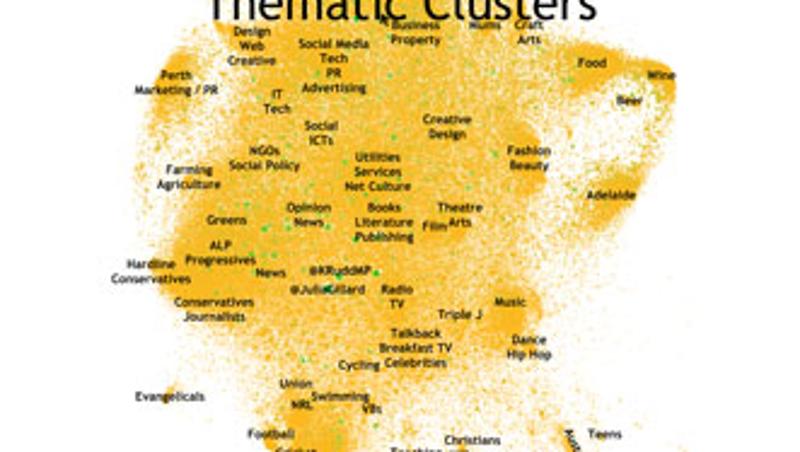
The first map of the Australian 'Twittersphere' has been generated by researchers at QUT.
Associate Professor Axel Bruns and Dr Jean Burgess from the ARC Centre of Excellence for Creative Industries and Innovation (CCI) at QUT said as many as two million Australians now used Twitter to exchange news, views and information.
By analysing topics of interest and concern to Australians the researchers have been able to build a 'network map' showing the connections between different issues and areas.
"Just as newspapers have circulation reports and TV has its ratings, it is important to understand the role which new media are playing in our society," Professor Bruns said.
"The map offers us a completely different way to view Australian society - not by where people live or what job they do, but by how they connect to each other through Twitter."
The map reveals clusters of interest in the 'Twittersphere' around major themes such as politics, the arts, sport, food, agriculture, rock bands, religion, real estate, business, celebrities, education and social media.
It shows how strongly or weakly these interest networks interlink with one another and with the 'Australian mainland' in the map.
"It gives us a strong sense of who is using Twitter, why and how. When a big issue comes along you can see parts or all of the network lighting up, much as in the brain scans used by neuroscientists," Professor Bruns said.
By mapping political hashtags, the researchers were able to pinpoint the moment when Tony Abbott began to draw ahead of Julia Gillard in terms of mentions on Twitter, or when Campbell Newman eclipsed Anna Bligh in the run-up to the Queensland election.
They were able to demonstrate nationwide interest in issues such as the Queensland floods, the Christchurch earthquake and in TV shows such as MasterChef.
By comparing tweets with and without web links in them, they were able to show how some people used Twitter to comment, while others used it to share information.
"For example in a crisis like the Queensland floods we saw a lot of people spontaneously sharing information to help one another," Professor Bruns said.
Dr Burgess said the map could be used to study developments in Australian politics, natural disasters or trends in public thought and opinion.
"It offers us a completely fresh way to view the discourse that is taking place between Australians or different groups," she said.
"It shows there are multiple, overlapping publics, interacting and interweaving in time and space across Australia."
The map also reveals which Twitter networks are isolated from the Australian 'mainland' tending to connect among themselves more than with other networks.
These include evangelical groups, cities like Adelaide and Perth, followers of pop stars, and sports and beer lovers.
The researchers based their map on data from 950,000 Australian Twitter accounts, but said that the national Twitter population is estimated to be as high as two million.
"There have been many claims made that online media fragments society and reduces links between people. Our maps demonstrate categorically this is not the case," Professor Bruns said.
"They provide clear evidence of both the strength and complexity of connections among Australians - at least those who use Twitter."
More information about the research conducted by the QUT team can be found at their project website http://mappingonlinepublics.net and the full presentation can be found here.
RELATED ARTICLES
Study of Bligh, Obama's campaign Twitter use
Role of social media in floods coverage and response




